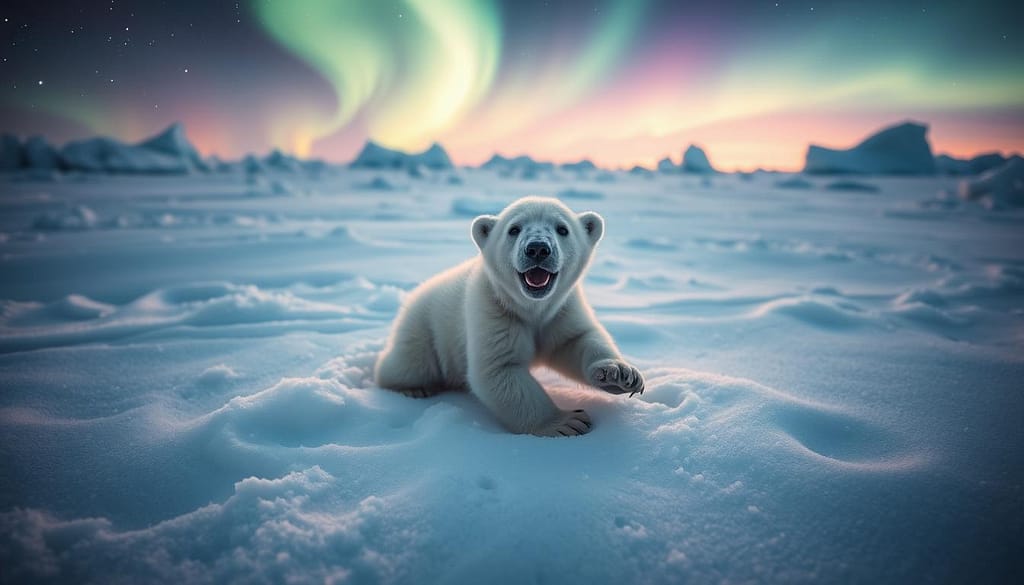Polar Bear Cubs: Survival in the Arctic Wilderness
In the Arctic’s frozen vastness, a remarkable story begins. Polar bear cubs start their lives in a world of ice and snow. They face huge challenges from the moment they take their first breath. These tiny balls of fur, born in winter’s heart, begin a survival journey in one of Earth’s toughest climates.

The Arctic, a vast and harsh landscape, is both home and battleground for these young bears. As they grow, they must adapt to extreme cold, dangerous ice, and the endless search for food. Their story is one of resilience, showing nature’s incredible ability to survive in the most challenging places.
Groups like Polar Bears International work hard to study and protect these amazing animals. Their work shows how important polar bears are to the Arctic ecosystem. It also highlights the urgent need for conservation due to climate change.
Key Takeaways
- Polar bear cubs are born in the harsh Arctic winter
- The Arctic environment poses significant survival challenges
- Cubs must quickly adapt to extreme cold and ice conditions
- Polar bears play a crucial role in the Arctic ecosystem
- Climate change threatens the survival of polar bear populations
- Conservation efforts are vital for protecting polar bears and their habitat
The Birth and Early Life of a Polar Bear Cub
Polar bear cubs start their lives in a remarkable place. A female polar bear builds a cozy den in the snow. This den is a safe space for her and her newborns.
Birth and Nesting
Inside the den, the female polar bear gives birth to her cubs. These tiny ones are blind, toothless, and weigh about one pound. The den keeps them safe from the cold Arctic outside.
Nursing starts right after birth. Polar bear milk is full of fat, helping the cubs grow fast. The mother doesn’t eat, using her fat for milk.
Developmental Stages
The cubs grow quickly over the next few months:
- Eyes open after about 30 days
- Teeth emerge around 2 months
- Cubs start walking in the den at 2 months
- By 3 months, they’re ready to leave the den
When spring comes, the family leaves their snowy home. The cubs, now about 25 pounds, take their first steps on the sea ice. This is the start of their learning journey in the Arctic.
“The bond between a mother polar bear and her cubs is one of the strongest in nature. It’s a testament to the incredible adaptations these animals have developed to thrive in one of the world’s harshest environments.”
Survival Challenges for Polar Bear Cubs
Polar bear cubs face many challenges in their cold Arctic home. From the moment they leave their den, they must deal with harsh conditions and dangers.
Arctic’s Unforgiving Environment
The Arctic’s extreme climate is tough for cubs. Temperatures can drop to -40°F, testing their survival skills. The sea ice is key for hunting and travelling. But, as the climate warms, the ice melts sooner, cutting down the hunting time.

Threats from Predators
Adult polar bears have few predators, but cubs are at risk from wolves, Arctic foxes, and other bears. Male bears might even attack cubs, putting mothers always on guard.
Climate Change: A Growing Concern
Climate warming is changing the Arctic, affecting polar bears. In Hudson Bay, less sea ice means bears spend more time on land. This makes it harder for them to find seals, their main food.
“The rapid changes in Arctic sea ice are outpacing the polar bears’ ability to adapt, putting tremendous pressure on cub survival rates.”
As these challenges grow, the future of polar bear cubs is uncertain. Their success in overcoming these obstacles will decide the future of polar bears.
Learning to Hunt and Survive
Polar bear cubs face a tough learning curve in the Arctic. They must quickly learn survival skills to thrive. The mother polar bear is key in teaching them.
Training from the Mother
Mother polar bears teach their cubs important skills. Cubs grow fast, soaking up knowledge. They learn to swim and hunt seals, their main food.
The training is intense. Cubs watch their mother closely, learning by example. They practice stalking on land and in water. This is vital for their survival.
First Hunting Experiences
As cubs get stronger, they join hunts. Their early tries are often awkward but get better. They learn to spot seals, approach quietly, and time their attacks.
- Spot seals on ice
- Approach silently
- Time their pounce perfectly
Cubs don’t eat much solid food at first. They rely on their mother’s milk. As they grow, they start to eat their mother’s catches. This prepares them for hunting on their own.
“The bond between a mother polar bear and her cubs is incredible. It’s a masterclass in survival skills.”
Through these experiences, polar bear cubs learn to survive alone in the Arctic. Their fast growth and learning show how effective their mother’s teaching is.
Conservation Efforts to Protect Polar Bears and Cubs
Protecting the polar bear and cubs is a big job. Many groups are working hard to keep these amazing animals safe. They also aim to protect their Arctic habitats.
Environmental Protection
Polar Bears International is a key player in saving polar bears. They work to keep the Arctic ecosystem healthy. This is crucial for polar bears to survive.
Their efforts include:
- Tracking adult males and subadults to understand migration patterns
- Studying how polar bears reproduce in changing climate conditions
- Educating the public about Arctic conservation

You can donate to help with these important projects. Every bit of support helps protect polar bears and their cubs for the future.
Challenges Facing Conservationists
Conservationists face many challenges in their fight to save polar bears. Climate change is the biggest threat, melting sea ice and shrinking hunting areas. Other challenges include:
- Oil and gas exploration disrupting polar bear habitats
- Increased human-bear conflicts as bears move inland
- Limited resources for extensive research and protection efforts
Despite these challenges, conservationists keep working hard. They aim to make sure polar bears can live safely in their Arctic home for years to come.
Conclusion
The journey of polar bear cubs in the Arctic is a tale of survival against harsh odds. From birth in cozy dens to their first steps on icy terrain, these cubs face numerous challenges. Their lives are shaped by the unforgiving Arctic climate and the ever-present threat of predators.
Climate change poses a growing risk to polar bear survival. As sea ice melts, these magnificent creatures struggle to find food and maintain their traditional hunting grounds. Conservation efforts are crucial to protect polar bears and their cubs from the impacts of global warming.
The bond between a polar bear mother and her cubs is vital for their survival. Through her guidance, cubs learn to hunt seals and navigate the icy landscape. This knowledge is essential for their long-term survival in the Arctic ecosystem.
As we look to the future, continued research and conservation work are key to ensuring polar bears thrive. By understanding their needs and protecting their habitat, we can help these iconic Arctic animals face the challenges ahead. The survival of polar bear cubs is not just about preserving a species, but about maintaining the delicate balance of our planet’s ecosystems.
FAQ
When are polar bear cubs born?
Polar bear cubs are born in late December or early January. This is when their mothers are in the den.
How long do polar bear cubs stay in the den?
Newborn cubs stay in the den for three to four months. It’s warm and safe there.
What do polar bear cubs weigh at birth?
At birth, cubs weigh about 0.6 to 0.7 kg (1.3 to 1.5 lb). They are tiny and need their mother’s milk to survive.
How quickly do polar bear cubs grow?
Thanks to their mother’s milk, cubs grow fast. They can gain 1 kg (2.2 lb) per week.
When do polar bear cubs emerge from the den?
Cubs leave the den in late March or early April. They are ready to explore the sea ice with their mother.
What role does the mother play in teaching her cubs?
The mother teaches her cubs to hunt seals, swim, and navigate the Arctic. This is crucial for their survival.
How long do polar bear cubs stay with their mother?
Cubs stay with their mothers for two to three years. They learn important survival skills before venturing out alone.
What threats do polar bear cubs face in the Arctic?
Cubs face harsh weather, predators like adult males, and climate change impacts their sea ice habitat.
How can we help protect polar bear cubs and their habitat?
We can support conservation, reduce our carbon footprint, and donate to organizations like Polar Bears International. This helps protect cubs and their habitat.
